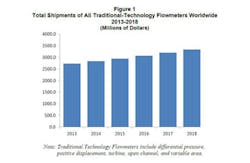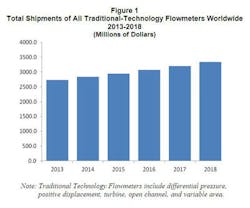New Flow Research study finds $2.7 billion worldwide traditional technology flowmeter market
A new research study from Flow Research, Volume X: The World Market for Flowmeters, 5th Edition, finds that the worldwide traditional technology flowmeter market totaled $2.7 billion in 2013 and is projected to grow to exceed $3.3 billion by 2018. Traditional technology flowmeters include differential pressure, positive displacement, turbine, open channel, and variable area flowmeters. All these flowmeter types were introduced before 1950, and have a large installed base.
The differential pressure (DP) and open channel flowmeter markets are showing the fastest growth, with the DP flowmeter market the largest of the group in terms of revenues. Flow Research projects a compound annual growth rate (CAGR) in revenues for the total worldwide traditional technology flowmeter market of 4.1 percent from 2013 to 2018.
Despite a trend towards new-technology flowmeters, traditional technology flowmeters have been holding their own in the worldwide flowmeter market. One reason is their large installed base. Differential pressure flowmeters have been around for over 100 years, and have been extensively studied and used for liquid, gas, and steam flow measurement. Differential pressure and turbine flowmeters in particular were the first to receive approvals from the American Gas Association (AGA) for use in custody transfer of natural gas. While Coriolis and ultrasonic flowmeters have also received corresponding approvals in the past 20 years, DP and turbine meters were already entrenched in the custody transfer market at this point.
Positive displacement flowmeters have also received approvals from the American Petroleum Institute (API) for use in custody transfer measurement of petroleum liquids. Here they compete with Coriolis flowmeters that have also received API approvals for this purpose. Oval gear positive displacement flowmeters are incorporated into skids that are used for downstream custody transfer measurement of petroleum liquids.
Turbine flowmeter suppliers have been very active in new developing products and products with new features. For example, they have begun using ceramic and sapphire ball bearings that increase the reliability and longevity of turbine meters. Other innovations include dual rotor turbine meters and reversible flow turbine flowmeters with enhanced diagnostic features. Some turbine meter suppliers are researching new flowmeter designs that have the potential to reduce cost while enhancing the accuracy of both insertion and inline turbine flowmeters.
Another important area of development is primary elements. Primary elements are used together with differential pressure transmitters to measure flow by placing a constriction in the flowstream. One innovation from Emerson Process Management incorporates a DP flow transmitter with a primary element such as an orifice plate or an averaging Pitot tube to form an integrated DP flowmeter that can be calibrated as a single unit before shipping. Research is also occurring on Venturi tubes, flow nozzles, and averaging Pitot tubes. McCrometer’s V-Cone® reduces the need for straight upstream pipe run. Improvements in primary elements help make DP flowmeters suitable for specific niche areas, including those in the oil & gas industry.
Flow Research sent questionnaires to more than 400 people at over 250 flow companies for the study, which includes all 12 types of commercial and industrial flowmeters used in the process industries, including the emerging technologies of sonar and optical.
According to Dr. Jesse Yoder, president of Flow Research, traditional technology flowmeters will be around for many years to come:
“Traditional technology flowmeters have demonstrated a staying power that has surprised some analysts. Positive displacement flowmeter suppliers have improved the performance of their meters with improved manufacturing methods yielding greater precision and accuracy. Turbine flowmeter suppliers are using superior materials and researching new designs that could change the face of the turbine flowmeter market. Primary elements suppliers are improving their product lines with new orifice plate and fitting designs, and with designs that incorporate two different primary element types into a single type. One example from Veris, Inc. combines a flow nozzle with an averaging Pitot tube. While new-technology flowmeters still have an edge in most flowmeter markets, the innovative approach taken by many traditional technology flowmeter suppliers will keep these meters competitive for many years to come.”
Figure 1 shows projected shipments of traditional technology flowmeters worldwide in millions of dollars from 2013 to 2018. Residential flowmeters are not included.
About Flow Research
Flow Research, with headquarters in Wakefield, Massachusetts, is the only independent market research company whose primary mission is to research flowmeter and other instrumentation products and markets worldwide. Flow Research specializes in flow measurement devices, and conducts market research studies in a wide variety of instrumentation areas that can be purchased by anyone interested in the topics. These studies are developed through interviews with suppliers, distributors, and end-users. Topics include all of the flowmeter technologies – both new and traditional – as well as temperature sensors, temperature transmitters, level products, and pressure transmitters. The company has a special focus on the energy industries, especially on oil and gas production and measurement.
For more information, visit www.flowresearch.com or call +1 781 245-3200. For information on the Volume X flowmeter study, visit http://www.flowvolumex.com.

